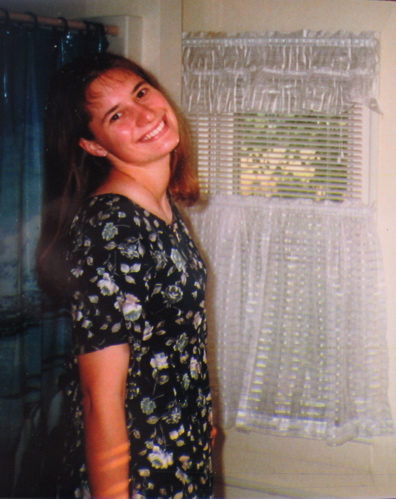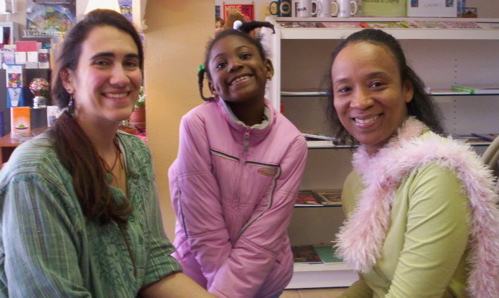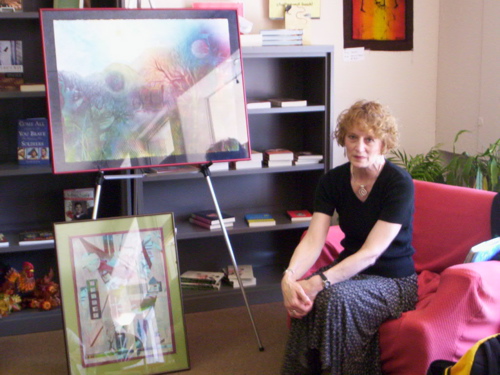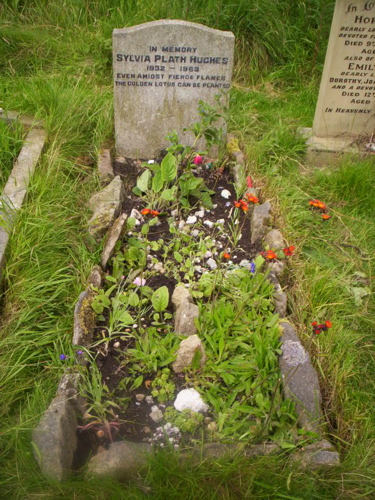Journal Excerpt – May 11, 2008. Through the bedroom window I see northeast wind  blow fuchsia petals from a tree. Spring is closing; summer is nearing. It was April 2002 when Sam and I came into contact again; she recently had moved into her mom’ house. We met at her crossroads, apparently to grant me access again to her life. I believe now it is for the purpose of sharing her story, though I’m not sure exactly how.
blow fuchsia petals from a tree. Spring is closing; summer is nearing. It was April 2002 when Sam and I came into contact again; she recently had moved into her mom’ house. We met at her crossroads, apparently to grant me access again to her life. I believe now it is for the purpose of sharing her story, though I’m not sure exactly how.
Where do you start sharing a story about someone who died? Do you start with their life or their death?
Samantha Kirsten Straight, born 9 May 1974, grew up to be a high-school teacher but was born a poet. Sam graced my life in two parts: the one when we knew each other for several years, and the second six months before she died. Despite being one year older than me, Sam always felt like a younger sister. The world lost Sam to suicide, and this “Breaking the Silence” essay is about striving for wholeness/ balance/ wellbeing by learning from anyone “deemed” ill.
Photo: Samantha. Credit: family.
At last month’s Gallery Walk event at Everybody Reads bookstore, I hosted “The Art & Craft of Storytelling”, featuring two talented beautiful artisans. Rina Risper –  President and Publisher of The New Citizens Press, and a commanding poet – shared the story of her quilt, a creative endeavor that took years to complete and is registered as part of Michigan history. Also featured was Gail Bohner, a visual artist and awarded educator, who brought two paintings and an altered book. All of these pieces are in memory of her eldest daughter Samantha (Straight) House, who died 4 November 2002.
President and Publisher of The New Citizens Press, and a commanding poet – shared the story of her quilt, a creative endeavor that took years to complete and is registered as part of Michigan history. Also featured was Gail Bohner, a visual artist and awarded educator, who brought two paintings and an altered book. All of these pieces are in memory of her eldest daughter Samantha (Straight) House, who died 4 November 2002.
Photo: MDH, Anissa (daughter of Rina), & Rina Risper. Credit: Scott Harris.
One of the paintings”Going Home” incorporates Gail’s memories of Sam’s loves in life including turtles. As Gail explained the layered images, I noticed a woman standing and listening. When a pause arrived, I invited the woman to take a seat. Following the event, the woman told me that she hadn’t known what this event would be, that she hadn’t expected “it”. She shared with tears that she has a son who’s schizophrenic and has tried to commit suicide. I introduced her to Gail and the two spoke privately for some time.
 This woman “happened” upon the story of Samantha, her life and loss to suicide, as well as the story of the mother who survives her. I am reminded of the day Sam and I “happened” upon one another outside the MSU Union Building, despite its many entrances. I hadn’t heard from her in years, despite my birthday and holiday cards. Much to my amazement, she spoke with me and exchanged phone numbers. In the months to come, we reconnected.
This woman “happened” upon the story of Samantha, her life and loss to suicide, as well as the story of the mother who survives her. I am reminded of the day Sam and I “happened” upon one another outside the MSU Union Building, despite its many entrances. I hadn’t heard from her in years, despite my birthday and holiday cards. Much to my amazement, she spoke with me and exchanged phone numbers. In the months to come, we reconnected.
Photo: Gail Bohner with paintings. Credit: MDH.
What stood between Sam and I for years? She had cut off friends connected to “Church”, which is how we first met. Her disassociation followed her hospitalization after Sam stopped taking meds without medical supervision. Her decision to disassociate arrived in a letter, and it was a very painful separation for me. We were not best friends but I felt this woman a sister of some kind.
Samantha was diagnosed bipolar in adolescence. (Learn more about living bipolar from blogger Julie Fast.) Her first suicide attempt “happened” in adolescence. I, on the other hand, struggled with chronic depression since childhood, which was diagnosed in therapy as an adult. While the thought of suicide visited me in adolescence and resurfaced at very dark times, I have not taken physical action. Nonetheless, shame burned me at the thought of medicating for depression. One day my psychologist pointed out how I already self-medicated with numbing behaviors that fostered imbalance in my life.
Then the day came when I was at work when a student told me, “You don’t look so good.” I could no longer stop the tears and went home. For a week between waves of terror, I read Susan Sontag‘s The Volcano Lover and visualized suicide. Despite the filled prescription of antidepressants I had on hand for months, I was waiting for “official” affirmation to take “happy pills”. I think my greatest terror was what would happen next: would the medication make a lasting difference?
Medication has not been the solution to wholeness, what I find to be a quest for wellbeing or balance. Medication has been one of many resources alongside changes over time: decisions about work settings, honesty about what fosters my happiness in light of limitations and strengths, boundary-setting with family. And while taking antidepressants, I have relapsed with self-medicating habits and again returned to their disuse.
Silence and mis-representations too often entomb individuals living with depression and other “mental illnesses”. Silence and mis-stories – AKA “mysteries” – too often shroud women lost to suicide, persons momentarily overwhelmed with individual circumstances reflecting a wider world’s condition. This shrouding happens whether the suicide of the person lost becomes a spectacle, like posthumous Pulitzer prize recipient Sylvia Plath, or an erasure, like Beatnik poet Elsie Cowen.
circumstances reflecting a wider world’s condition. This shrouding happens whether the suicide of the person lost becomes a spectacle, like posthumous Pulitzer prize recipient Sylvia Plath, or an erasure, like Beatnik poet Elsie Cowen.
Yet our language and conceptions of “mental illness” fail to touch the core of the matter: every kind of illness reveals an imbalance in our world. Every single person is faced with the challenge of balance, or wellbeing, because any excess in one part of life is accompanied by the neglect of another. Furthermore, imbalance is not a simple matter of one’s personal fault: Just as we are not singly responsible for someone’s loss to cancer, we are not to be singled out as “responsible” for someone’s loss to suicide. Equally, individual responsibility is not minimized from this perspective but is tied to each of us.
Photo: Grave of Sylvia Plath, Hebden Bridge, England, July 07. Credit: MDH.
Our personal lives illustrate that we are a revelation of the wider world, its history and possibility, which presents us with the opportunity – and the choice – to learn. Too often, though, guilt hinders the growth necessary to learn from the illness or loss of another person. Guilt immobilizes and is self-absorbing. Guilt prevents us from engaging one’s self in relationship to the world.
Shame also is an anti-legacy to the living. Shame, and its common partner fear, keeps us hidden from the wider world. These darker emotions are related though each has its own way of impeding honesty. Sharing our stories is to learn what someone’s illness or loss to suicide may teach each of us as well as the wider world. Conveying these stories is the antidote to shame, fear, and guilt. Honoring lives by breaking the silence, as varied as those expressions may be, is necessary in the process of healing – of seeking balance/ wellbeing/ wholeness.
*********************************************************************
Breaking the Silence is a series of essays by Melissa Dey Hasbrook. The series’ concept is explained here: What Do You Think?.
Post updated: 28 January 2009.

Lessons for the Wider World by Melissa Dey Hasbrook is licensed under a Creative Commons Attribution-Noncommercial-No Derivative Works 3.0 United States License.


Pingback: The Last Seasons of Our Friendship - Dey of the Phoenix
Dear Friend
I am touched by the poem. Keep poetry in your work it seems as gift for you for us. Love, Luisa
Pingback: Brigit’s Fire - Dey of the Phoenix
You are someone special and did/do make a difference in one’s life and death. My spirit is moved, as your words of beauty and illumination bring quite strength, that subdue the dark unruly side of my soul. Thanks.
Lucas James.
thanks, lucas, for your kind words. as each of us share what strengthens us on our journey, we are able to carry one another through darkness. peace.